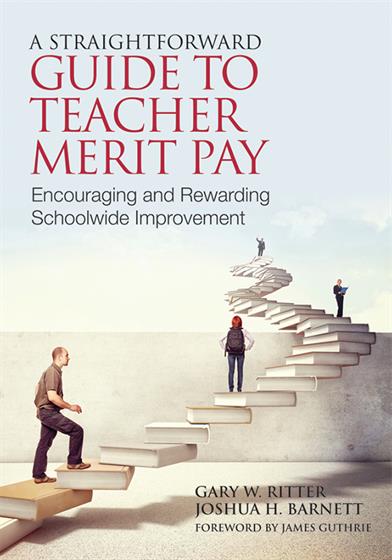
Hands-on, Practical Guidance for Educators
From math,
literacy, equity, multilingual learners, and SEL, to assessment, school counseling,
and education leadership, our books are research-based and authored by experts
on topics most relevant to what educators are facing today.

A Straightforward Guide to Teacher Merit Pay
Foreword by James Guthrie
National Superintendents Roundtable
This step-by-step approach to introducing performance-based pay helps districts avoid common pitfalls and put best practices into action, including collaboration with teachers to design balanced assessments.

- Grade Level: PreK-12
- ISBN: 9781452255514
- Published By: Corwin
- Year: 2013
- Page Count: 136
- Publication date: May 09, 2013
Review Copies
Description
Reward your best teachers for the great work they do!
Is your school system considering teacher merit pay? Now is the time to understand the potential benefits and pitfalls of performance-based teacher pay, as well as how today’s most successful programs were developed. Drawing on substantial research with school districts, Gary Ritter and Joshua Barnett provide a step-by-step approach to setting up a merit pay system in your school district. Readers will find
- An overview of existing merit pay programs and their strengths and weaknesses
- A review of the 12 most common myths about merit pay, and how school leaders can respond
- Six guiding principles for designing a merit pay program, along with how-to’s and timelines for every phase
- Guidance on creating balanced assessments based on multiple measures of teacher effectiveness, and developed in collaboration with teachers
Ensure that your district’s merit pay program supports teachers’ professional growth, schoolwide progress, and student achievement.
“Ritter and Barnett bring much-needed researched clarity to this complex issue. For school administrators, education policy makers, legislators, and others interested in school reform, this book is a must-read.”
—Rod Paige, Former U.S. Secretary of Education
“This guide is a useful resource for undertaking merit pay, preventing pitfalls, and most importantly, offering solid recommendations for creating well-designed implementations.”
—Gary Stark, President and CEO
National Institute for Excellence in Teaching
Key features
Table of Contents
Foreword
Preface
Acknowledgments
About the Authors
1. Introduction: Merit Pay as Educational Fad or Genuine Solution
What Is Merit Pay?
Why the Interest in Merit Pay?
What’s Wrong with the Current Salary System?
How Might Merit Pay Help?
Why is Merit Pay So Complicated?
2. Why Is Merit Pay Gaining Momentum? A Brief History
3. What Can a Merit Plan Do for Your Teachers and Students?
Evidence on Merit Pay
Studies on Teacher Attitudes
Studies on Student Achievement
Summary of Evidence
4. The Top 12 Criticisms of Merit Pay
1. Merit Pay Discourages Teaching Disadvantaged Students
2. Merit Pay Encourages Teaching to the Test
3. What About Teachers of Nontested Subjects?
4. Merit Pay Assumes Teachers Teach for the Money; They Don't!
5. Teacher Merit Is Just Too Hard to Measure
6. Merit Pay Ratings Are Based on a Secret Formula
7. Teachers Are Already Working as Hard as They Can
8. Merit Pay Bonuses Are Too Small to Matter
9. How Is Measuring Teacher Effectiveness Supposed to Improve Instruction?
10. Merit Pay Encourages Counterproductive Competition and Discourages Collegiality
11. States Can't Afford Merit Pay During Times of Fiscal Austerity
12. Merit Pay Is an Unproven Reform
5. Guiding Principles and Pesky Questions
Guiding Principles for Designing and Implementing a Merit Pay Plan
Principle 1: The Evaluation System Must Be Clear and Understandable
Principle 2: Consistent Communication Is Critical
Principle 3: Evaluations Should Be Based on Multiple and Thoughtful Measures of Effectiveness
Principle 4: Plans Should Actively Encourage Collaboration and Discourage Counterproductive Competition
Principle 5: Merit Pay Plans Should Be Part of a Comprehensive School Improvement Strategy
Principle 6: Merit Pay Bonuses Should Be Substantial and Meaningful
Pesky Questions
Identifying Program Participants
Measuring Teacher Effectiveness
Ratings and Rewards
6. Timelines for Program Development and Implementation
Program Implementation Timeline
Step 1: Mulling It Over
Step 2: Organizing a Merit Pay Exploratory Committee
Step 3: First Meeting With the Exploratory Committee
Step 4: Introducing the Concept to the Full School Community
Step 5: Details, Details, Details
Step 6: Finalizing and Ratifying the Plan, or "Rocking the Vote"
Step 7: Getting Ready to Roll Out the Plan
Step 8: Gentlemen, Start Your Engines
Step 9: Checking In
Step 10: Show Me the Money
7. RAMP: Ramping Up Teacher Pay in Your School
RAMP: General Overview
RAMP: Details
Supervisor Evaluation
Schoolwide Student Achievement
Individual Classroom Achievement
Translating the Ratings Into Dollars
Closing
8. Conclusions
Finding Funding
Expectations for Your Program
Closing
Appendix A: Sample Teacher Survey
Appendix B: Project on Incentives in Teaching (POINT) Teacher Survey
Appendix C: Sample Report Card
References
Index
RAMP: Applying the Principles
Reviews
"In place of one-size-fits-all systems of teacher evaluation and compensation, A Straightforward Guide to Teacher Merit Pay helps policymakers and leaders craft systems that value clarity, communication, and collaboration. As researchers who work closely with schools and districts to improve instruction and management, Ritter and Barnett appreciate nuance and address concerns in a thoughtful and fair-minded fashion. This volume will serve as an invaluable resource to school, district, and state leaders seeking to design pay systems that will encourage innovation and reward excellence."Rick Hess, Director of Education Policy Studies/Resident Scholar
American Enterprise Institute
"Performance pay for teaching has increasingly become part of the national education agenda to improve teacher quality and student outcomes. As a result, more and more states, districts, and schools are making performance pay a cornerstone of their strategy to revolutionize the way teachers are trained, supported, evaluated, and compensated. The question is: How can we start schools on the right foot to sustain performance pay over the long term? We know that performance pay systems are more likely to work when teachers are trained on the plan and support it from the outset. This guide is a useful resource for undertaking merit pay, preventing pitfalls, and most importantly, offering solid recommendations for creating well-designed implementations."Gary Stark, President and CEO
National Institute for Excellence in Teaching
"Current teacher compensation systems are inefficiently structured and deficient in attracting America's best graduates to teaching and retaining the best teachers. After years of different approaches and rigorous analyses, we have learned much about the performance pay debate, including what doesn't work. Ritter and Barnett provide a thoughtful and comprehensive examination of this complex topic, cutting through key issues that school leaders must address in order to establish a performance pay plan that has the best chance for success."Dr. Matthew G. Springer, Assistant Professor of Public Policy and Education/ Director
National Center on Performance Incentives
"The education reform initiative referred to as teacher merit pay has unleashed a tsunami of controversy throughout the nation. Even as the issue is hotly debated, the complex elements underpinning the value and implementation of an effective model of teacher merit pay is not only little understood, more egregiously, creditable information on the issue has been, until now, limited. Fortunately, Ritter and Barnett's great book brings much needed researched clarity to this complex issue. For school administrators, education policymakers, legislators, and other interested in school reform, it's a must-read."Rod Paige, Former US Secretary of Education
"A Straightforward Guide to Teacher Merit Pay is a great handbook for anyone wanting to learn about merit pay plans and considering how to get such a process started. It is easy to read and contains lots of examples and ideas based on the experience of the authors."Gloria L. Johnston, Consultant and Coach
Achievement Equity, Inc.
"A Straightforward Guide to Teacher Merit Pay examines the research and history of merit pay that is quite enlightening to those who may not know so much on the topic, as well as by those who think they know about this topic. The practical recommendations are grounded in common sense and experience. Decision makers will be delighted in the way in which the authors present this topic."Jude A. Huntz, Chancellor
Catholic Diocese of Kansas City, St. Joseph, MO
"A Straightforward Guide to Teacher Merit Pay presents a thoughtfully crafted and research based investigation of how merit pay could work in a school system. For policymakers and practitioners alike, the principles for developing a merit plan in this book should reframe the merit pay debate. Moreover, school leaders will resonate with how skillfully the authors have bridged theory with practice to offer a practical guide to proposing and implementing a merit based pay system."John C. Pijanowski, Associate Professor of Educational Leadership
University of Arkansas
"A Straightforward Guide to Teacher Merit Pay is your one-stop resource for understanding the history, research, and implementation tools for establishing a merit pay program in your school or district."James Drexler, Dean of Education
Covenant College
"As a former middle school principal and school superintendent, I have had 20 years of experience with performance pay in the state of Arizona. I wish I had read this book before embarking on my performance pay journey. The timelines for program development and implementation are exactly the steps I would follow if I were to begin my journey again. Congratulations to the authors for writing such an outstanding text to help the school leaders of the future."L. Thomas Heck, Clinical Associate Professor
Arizona State University
"Gary Ritter and Joshua Barnett give a great overview on merit pay in terms of history and the positive and negative aspects. The authors give the advantages that developing this program can have for a school."Gary Lee Frye, Homeless Liaison/Grant Writer
Lubbock-Cooper ISD, TX
"Gary Ritter and Joshua Barnett have captured and shared extensive information that provides historical background as it relates to and resulted in the current context of the public schools. A Straightforward Guide to Teacher Merit Pay has helped me process my thinking through four decades in the profession."Douglas Gordon Hesbol, Educational Consultant and Retired Superintendent
Yorkville, IL


